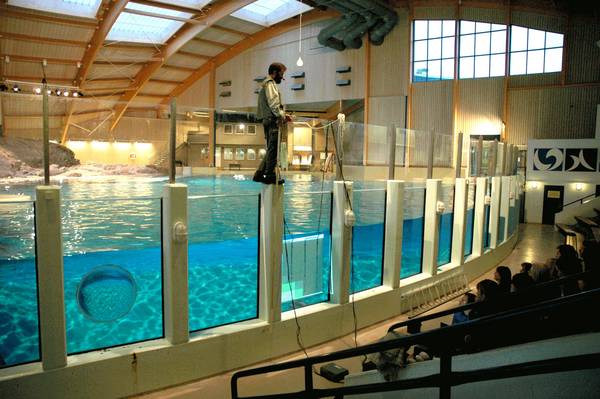ELVIS - an EchoLocation and Visualization Interface System
We have developed an EchoLocation Visualization and Interface System (ELVIS) designed for dolphin research.
The system can visualize the dolphin echolocation by interpreting the signals from an array of hydrophones and creates a video image representing the location and intensity of the dolphin sound. This video image can be viewed by the researcher. This makes it easier to understand how the dolphin uses its echolocation. Another very exciting feature is that the video image also can be shown to the dolphin in real-time, making it possible for the dolphins to draw computerized pictures for the first time in history!
By further developing this feature it is also possible to set up the system as an acoustically operated touch screen. Then the dolphins can use their quite narrow sonar beam to click on buttons on the screen in the same manner as we use the mouse cursor on a computer.
This interdisciplinary project has two main goals:
- To learn more about dolphin behavior, cognition, sonar skills and intelligence
- To overcome technical difficulties related to further improvements of the system, so that it continues to be one of the most capable echolocation measurements systems in the world
Description of the system
ELVIS is constructed basically out of four main building blocks:
- a screen with ultrasound sensors
- a signal conditioning box
- a computer
- a video projector
The first version of ELVIS has a semi-transparrent screen with 16 hydrophones (microphones made for underwater use and in this case designed to measure sounds in the ultrasound range) lowered into the pool water in the Lagoon at Kolmården Wild Animal Park. The pool wall is made of glass so that the screen can be viewed both from the outside and from the inside of the pool.
The signals from the hydrophones are filtered and amplified so that the computer can handle the signals properly. The signals are interpreted by the in-house designed computer software and converted into a video image reflecting the location, sound intensity and other properties of the dolphin sound.

In the foto above the visual feed back of the dolphin's sonar beam is represented by a light intensity graph. You can see the dolphin echolocating at the lower corner of the screen.
According to what suites the application best, a variety of different video images can be projected back onto the screen so that the dolphin gets immedeate visual feedback when it echolocates at the screen. For instance, a highlighted spot appear on the screen at the same location as the dolphin pointed its sonar beam. This makes the dolphin able to draw basically in the same way as we draw with the painbrush-tool in "Paint".
Click here if you want to se some video clips of a dolphin using ELVIS.
ELVIS in media
Below follows some links with more information about ELVIS.
- Norrköpings Tidningar 2007-10-10
- View a swedish WEB-TV broadcast: Web-TV 2007-10-10
- ?Snacka med delfiner? is a popular science presentation, broadcasted nationwide on TV through Kunskapskanalen 2012 and online at the Utbildnings Radions webpage www.ur.se/Produkter/169710-UR-Samtiden-Lundaforskare-forelaser-Snacka-med-delfiner
- Theme package at the website of Nationalencyklopedin, ?NE Skola? visited by thousands of teachers and elementary school students every week (Source: Nationalencyklopedin) (Direct link: www.ne.se/repj/delfinljud-som-forsknings%C3%A4mne) (User account required)
- South Baltic web lab blogger 2012: www.balticweblab.eu/blog-learning-from-dolphins.html
- An article in LO-tidningen, 2009.
- An article in Ny Teknik www.nyteknik.se/nyheter/innovation/forskning_utveckling/article3187568.ece
